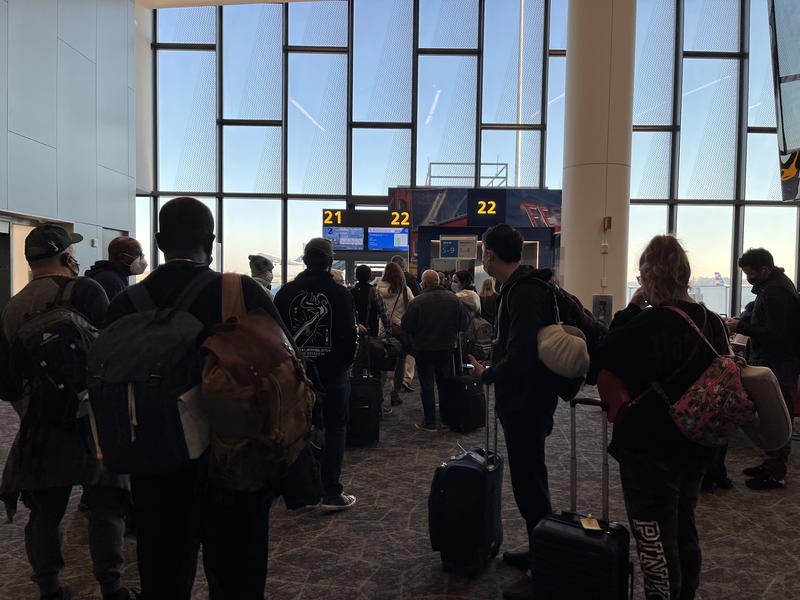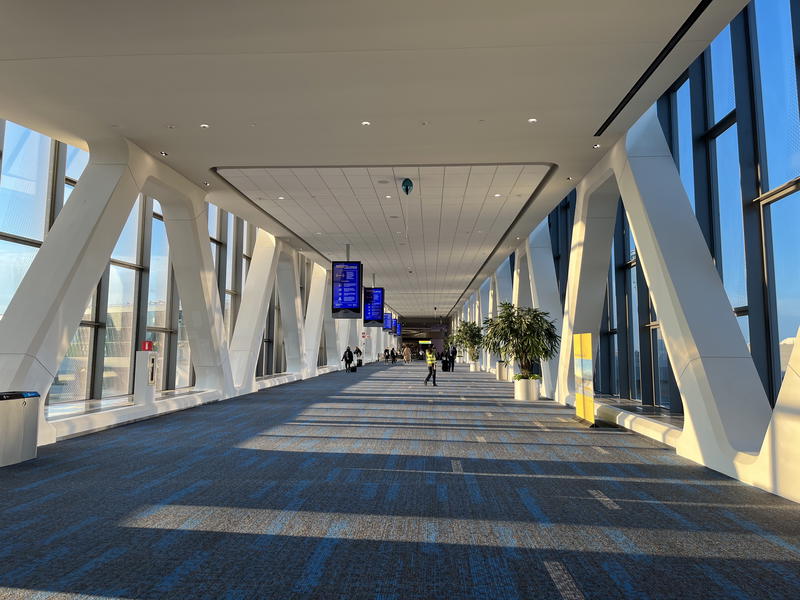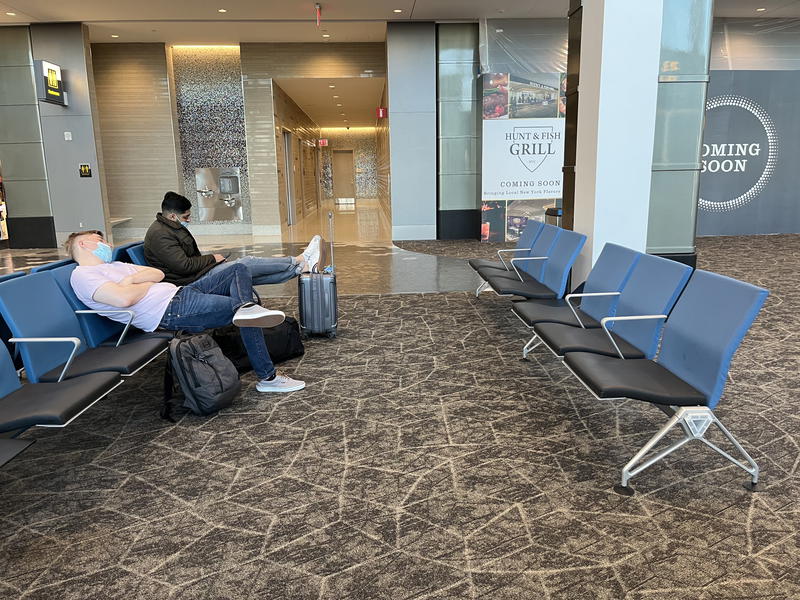What Is a Layover?
A layover is what happens when you take a flight from one place to another, with a stop in the middle. During a layover, your first flight will be to the layover destination, and then you can fly from the layover airport to your final destination. Layovers can be short, or longer, letting you exit the airport and see a new place.
Table of contents
- How long are layovers?
- Can layovers be multiple days?
- Do I need to leave the plane on a layover?
- Can I leave the airport during a layover?
- How does my luggage get to my final destination on a layover?
- What happens if I get off the airplane at my layover and never return?
- How to spend a layover at the airport
- Are non-stop flights better than layover flights?
This article may contain affiliate links. We earn a small commission when you purchase via those links — at no extra cost to you. It's only us (Becca & Dan) working on this website, so we value your support! Read our privacy policy and learn more about us.
How long are layovers?
Layovers can be anywhere from 30 minutes to a few days! Most layovers seem to be between two to eight hours, approximately.
When you book your flight and make note of the flight times, you will be able to see the time between flights. Usually, an airline will clearly denote the length of the layover, with some text like, “2 hours 51 minutes between flights.”
Travelers beware: if you’re exploring flight options with layovers, be very careful about flights that have a “+1” or “+2” posted next to the arrival date and time.
This means that the flight lands at the given time, an entire day (or two) after your first departure time. The “+1” or “+2” could be due to long layovers for connecting flights, or, they could be due to great differences in time zones, and across the International Date Line, like from Tokyo to NYC.
Layovers can be kind of fun! With a layover, you could have time to see a new destination or city, depending on the length and logistics. We had a whole day to explore the capital of Spain in this layover guide to Madrid.

Can layovers be multiple days?
Yes, layovers can be multiple days, if you count flights like multi-destination multi-leg flights to have layovers in between.
The longest a ‘by-the-book’ layover would be is probably around 24 hours. This is due to the schedules of flights available from your origin and to your destination.
For example, I flew from New York City (USA) to Cape Town, South Africa, and had three flight legs and two layovers (!).
The first layover was almost a day-long, in Frankfurt, Germany. During this time, I left the airport, and had checked my bag at my origin, in order to have it automatically put on my connecting flight without having to worry about what to do with it during my layover.
Then, I traveled solo in Frankfurt until I had to go back to the airport.

Because of the length of my layover (only one day), I was able to enjoy some sightseeing in Germany. When it was time to go back to the airport, I was still checked into my flight, and proceeded to board for the next leg, from Germany to Johannesburg, South Africa.
A layover could be multiple days indeed, meaning, it’s not out of the question. Especially now with some airlines like TAP Portugal that are marketing long layovers as chances to explore the cities of Portugal like Lisbon, multi-day layovers can be chosen by the passenger.
Do I need to leave the plane on a layover?
Passengers will usually leave the airplane during a layover. Because flights need to be cleaned and turned over in between flights, you almost always need to leave. There are some situations when you can stay in your seat, but it rarely happens.
The only case of this would be if the exact same plane is continuing to your final destination.
On one of the first flights that I took in 2006, I had a layover like this! It’s really called a “stop,” or “stopover.” This means that the plane just touches down to refuel or do something, and then it lifts off again and continues.
I once flew from Philadelphia to Nashville and the flight touched down, and took off again somewhere along that route. It is called a stopover in the instances when you can stay on the airplane.
Usually, a stopover is not too glamorous because no one is allowed to leave the airplane and all the passengers are getting pretty antsy.
Can I leave the airport during a layover?
Sometimes if you have a layover that is more than eight hours, some people like to try and get out and explore the city.
Note, however, that you can only do this if you have the correct visa, entry requirements and health requirements in place, because you are exiting that airport and going into the country where your layover is!
Considering that you need to be back at the airport about two hours before your next flight, exiting the airport during a layover can be a good way to see a new city for an afternoon (like my day spent sightseeing in Germany during a layover).
If you choose to leave, you’ll obviously need to go through security again. Consider that this means no liquids over 100 ml, and other limitations like that. You can save time going through security if you have TSA PreCheck (within the USA).
If you are in an international destination, be sure that you have a travel visa if you need one and intend to briefly leave. If not, you could really create some complications you’ve already made plans.

How does my luggage get to my final destination on a layover?
When you travel and check a bag at check-in, your luggage gets tagged with your origin, final destination and the airport codes of any layover locations.
When you land, the luggage gets taken off the airplane. If this is your final destination, your bag will arrive on the conveyer belt.
If you are continuing to a new city, your luggage will get driven to your new plane, or put in temporary storage until you take off. The more legs in your flight, the more room for error that the airline has to lose your bag. For this reason, I’d personally recommend getting some Apple AirTags, which will help you track your suitcase or checked item (a surfboard? musical instrument? stroller?) if it gets misdirected during transfers.

We almost always travel with carry-on luggage like this backpack, for example because we can guarantee that our bags will arrive with us! Now that we travel with a baby though, we’ll be checking things like a stroller or car seat.
Sometimes, if you intend to carry on your luggage, you can check your bag right before you board. You’ll hear an announcement asking people to volunteer their bags to go under the plane.
In cases like this, you have a better chance of getting your bag, in general. Your luggage is also probably going to be one of the first ones out at baggage claim, because it was the last to go in.
However, for layover flights, there is the greatest room for error in ensuring that you get your bag.
What happens if I get off the airplane at my layover and never return?
You’re really not supposed to do this because the airline is waiting for you to board your flight. It’s highly frowned upon, but you can do it.
When I was traveling to London, I had a layover through Iceland. Instead of going to London, I decided that I wanted to spend more time in Iceland. I got off the airplane and intentionally missed my connection.
There are two considerations for doing this.
1. Your bag won’t arrive with you.
If you check a bag, your bag will fly to your original destination. In my example, if I had checked a bag, it would be waiting in London for me to never get it.
This is one more benefit of carrying on your bag, if you can!
2. The rest of your itinerary will be canceled.
If you book a round-trip flight, your flight home will be canceled. Or if you have a multi-city trip planned, any additional flight be will canceled as well.
This could put a wrench in all your plans, and it’s avoidable!
How to spend a layover at the airport
Layovers can be pretty boring. Travel memberships like Priority Pass give you some more comfort and free food and drinks at lounges, when you are in an airport.
With Priority Pass, we’ve been able to enjoy hanging out in awesome airline lounges all around the world, from Mexico City to Hong Kong to Malaysia, all included with this subscription. You can see more about it in our list of great tools for travelers.
If you don’t have lounge access, you may have to hang around in an uncomfortable airport, and there may not be WiFi. You may wind up sitting on the floor if all the seats at the gates are taken.
If your flight is delayed, or if you get bumped, the airline might put you up at a hotel and you may be staying somewhere you completely didn’t intend to spend time.
The best ways to spend a layover at the airport are:
- Trying a restaurant, cafe or bar, especially if your layover is in a destination where there is interesting cuisine.
- Reading a book!
- Working on a project on your laptop.
- Taking a nap (as long as you set an alarm for when you have to be at the gate for departure)
- Making phone calls to family and friends (if you’re in your home country)
- Walking around the airport to get steps, if you’ve been sitting on a long flight and your back and legs are stiff.

Are non-stop flights better than layover flights?
Any time we fly, we look for non-stop flights first. They are so much easier and always faster.
For example, a non-stop flight from NYC to Guatemala City is 5 hours and 4 minutes.
If you take a flight from NYC>GUA with a short layover (and it will probably be cheaper, hence the reason that travelers will oftentimes have layovers!), it would be a 4-hour flight to Dallas, and then a 3-hour flight to Guatemala City, with a 1.5-hour layover in between at DFW.
All in all, the flight itinerary with the layover involves two more hours of flying and an hour and a half spent in another airport, waiting for the next flight. There’s also a chance that connecting flights can be delayed, adding to any delays you may have experienced on your first flight from your origin.
When we book non-stop flights, we don’t have to worry about running through the airport to catch our layover flight (like I did when I went to Guatemala with my layover, above!).
We don’t have to worry about layover gate changes, or worse, terminal changes. And we don’t need to run the risk of having part of our trip canceled or delayed.
However, sometimes flights that offer layovers can be cheaper (or, a LOT cheaper). It could sometimes be nearly unaffordable to purchase a non-stop flight, especially for farther destinations abroad.
If you have a frequent flyer miles program with an airline, or a miles program with a credit card, your reward flight might have a layover. This was exactly how I wound up with my three-part flight to Cape Town, South Africa: I had booked it on my United miles and this was the itinerary that showed up for me to pick.
In the event where we are aiming to save a lot of money when we travel, we’ll go with the layover flight and hope for the best!
📘 Learning travel terms with us?
We built this glossary to make travel planning clearer. If it helped decode a tricky term, we'd love a coffee so we can keep expanding it.
Support our glossary
